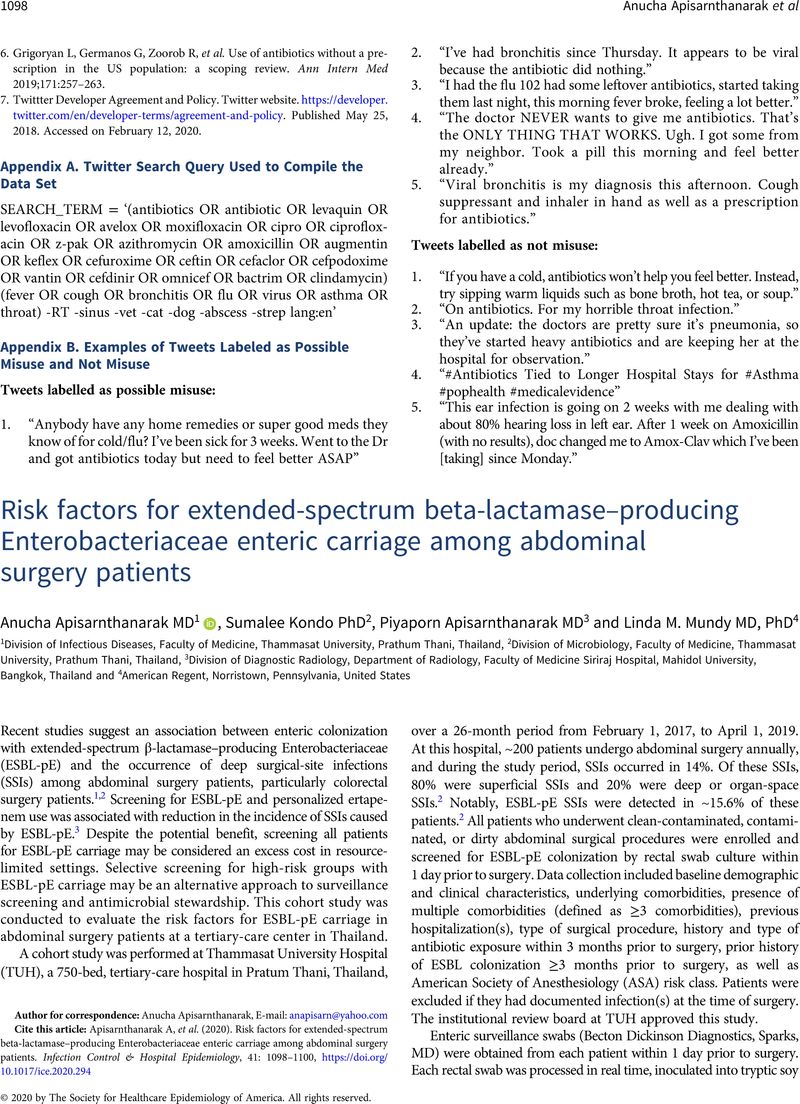No CrossRef data available.
Article contents
Risk factors for extended-spectrum beta-lactamase–producing Enterobacteriaceae enteric carriage among abdominal surgery patients
Published online by Cambridge University Press: 02 July 2020
Abstract
An abstract is not available for this content so a preview has been provided. Please use the Get access link above for information on how to access this content.

- Type
- Research Brief
- Information
- Copyright
- © 2020 by The Society for Healthcare Epidemiology of America. All rights reserved.
References
Dubinsky-Pertzov, B, Temkin, E, Harbarth, S, et al.Carriage of extended-spectrum beta-lactamase–producing enterobacteriaceae and the risk of surgical site infection after colorectal surgery: a prospective cohort study. Clin Infect Dis 2019;68:1699–1704.CrossRefGoogle ScholarPubMed
Apisarnthanarak, A, Kondo, S, Mingmalairak, C, et al.Outcomes of extended-spectrum beta-lactamase–producing Enterobacteriaceae among abdominal surgery patients. Infect Control Hosp Epidemiol 2019;40:1290–1293.CrossRefGoogle Scholar
Nutman, A, Temkin, E, Harbarth, S, et al.Personalized ertapenem prophylaxis for carrier of extended-spectrum beta-lactamases producing Enterobacteriaceae undergoing colorectal surgery. Clin Infect Dis 2020;70:1891–1897.CrossRefGoogle Scholar
Boo, NY, Ng, SF, Lim, VK.A case-control study of risk factors associated with rectal colonization of extended-spectrum beta-lactamase producing Klebsiella spp in newborn infants. J Hosp Infect 2005;61:68–74.CrossRefGoogle Scholar
Apisarnthanarak, A, Kiratisin, P, Saifon, P, Kitphati, R, Dejsirilert, S, Mundy, LM.Clinical and molecular epidemiology of community-onset, extended-spectrum beta-lactamase-producing Escherichia coli infections in Thailand: a case-case-control study. Am J Infect Control 2007;35:606–612.CrossRefGoogle ScholarPubMed
Apisarnthanarak, A, Kiratisin, P, Mundy, LM.Clinical and molecular epidemiology of healthcare-associated infections due to extended-spectrum beta-lactamase (ESBL)-producing strains of Escherichia coli and Klebsiella pneumoniae that harbor multiple ESBL genes. Infect Control Hosp Epidemiol 2008;29:1026–1034.10.1086/591864CrossRefGoogle ScholarPubMed
Luvsansharav, UO, Hirai, I, Nakata, A, et al.Prevalence of and risk factors associated with faecal carriage of CTX-M β-lactamase-producing Enterobacteriaceae in rural Thai communities. J Antimicrob Chemother 2012;67:1769–1774.CrossRefGoogle ScholarPubMed
Apisarnthanarak, A, Tunpornchai, J, Tanawitt, K, Mundy, LM.Nonjudicious dispensing of antibiotics by drug stores in Pratumthani, Thailand. Infect Control Hosp Epidemiol 2008;29:572–575.CrossRefGoogle ScholarPubMed
Thamlikitkul, V, Tangkoskul, T, Seenama, C.Fecal carriage rate of extended-spectrum beta-lactamase–producing Enterobacteriaceae as a proxy composite indicator of antimicrobial resistance in a community in Thailand. Open Forum Infect Dis 2019;6:ofz425.Google Scholar
Jazmati, N, Jazmati, T, Hamprecht, A.Importance of pre-enrichment for detection of third-generation cephalosporin-resistant Enterobacteriaceae (3GCREB) from rectal swabs. Eur J Clin Microbiol Infect Dis 2017;36:1847–1851.CrossRefGoogle ScholarPubMed



